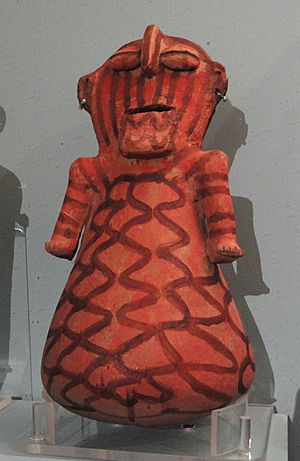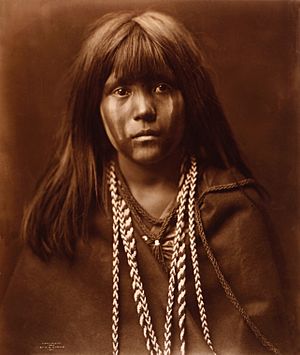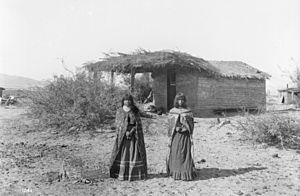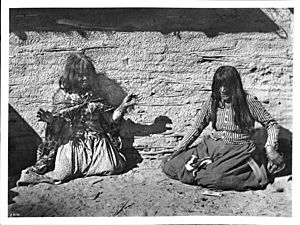Mohave people facts for kids
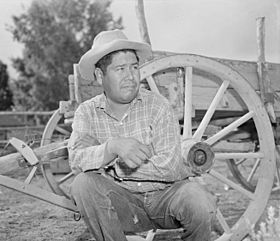
Henry Welshe, a Mojave tribal chairman, around 1944–46
|
|
| Total population | |
|---|---|
| About 2,000 people | |
| Regions with significant populations | |
| Languages | |
| Mojave, English | |
| Religion | |
| Indigenous religion | |
| Related ethnic groups | |
| Maricopa, Quechan, Walapai, Havasupai, and Yavapai |
The Mohave or Mojave (Mojave: Aha Makhav) are a Native American people. Their traditional homelands are along the Colorado River in the Mojave Desert. Today, they live mostly in Arizona, California, and Nevada.
Most Mojave people are members of two federally recognized tribes: the Fort Mojave Indian Tribe of Arizona, California & Nevada and the Colorado River Indian Tribes of the Colorado River Indian Reservation.
The Mojave have their own language, which is part of the Yuman language family. They also have special rights to use water from the Colorado River, which were granted to their reservations long ago.
Culture and Traditions
The Mojave people have a rich culture filled with unique traditions, stories, and art. They have passed down their way of life through many generations.
The Mojave Language
The Mojave language is part of a group of languages called the Yuman language family. It is very similar to the languages spoken by the neighboring Quechan and Maricopa peoples.
In the 1990s, only a small number of people still spoke the language fluently. Today, the Mojave tribes are working hard to teach the language to their children. They have created books and classes to help keep their language alive.
Beliefs and Stories
Mojave stories tell about the creation of the world. Their creator is a spirit named Matavilya, who created the Mojave clans. Matavilya's younger brother, Mastamho, gave the people the Colorado River and taught them how to farm.
The Mojave were skilled farmers who grew crops in the rich soil near the river. In their traditions, young people took part in a special ceremony to mark their journey into adulthood. This ceremony sometimes included the use of a sacred local plant to help them gain spiritual understanding.
The Story of the Mojave People
Because the Mojave language was not written down until modern times, their early history was passed down through oral history. This means that stories, songs, and traditions were shared by speaking and listening.
What Does "Mojave" Mean?
The name "Mojave" has been spelled in over 50 different ways, such as Hamock avi and Jamajabs. This has caused some confusion about its meaning.
For a long time, people thought "Mojave" came from the words hamock (meaning three) and avi (meaning mountain). They thought it referred to the three sharp mountain peaks near the Colorado River called The Needles.
However, the Mojave people call these peaks Huukyámpve, which means "where the battle took place." This name comes from an ancient story where the god-son, Mastamho, defeated a great sea serpent.
Homelands Along the Colorado River
The Mojave people's ancestral land, which they call Aha Macav, was a long stretch of land along the Colorado River. It started near what is now Hoover Dam and went south for over one hundred miles, past the modern city of Parker. A very important place in their homeland is Spirit Mountain, which they call Avi kwame. It is the center of their spiritual world.
Arrival of Newcomers
The first Europeans to meet the Mojave were Spanish explorers who arrived in 1604. Over the next 200 years, more Spanish travelers and missionaries visited their lands.
In the 1820s, American fur trappers, like Jedediah Smith, began to enter Mojave territory. As more American settlers moved west, conflicts between them and the Mojave became more common.
A Time of Great Change
In 1859, the United States Army, led by Colonel William Hoffman, traveled up the Colorado River. The army's goal was to build a fort to protect American settlers traveling through the area.
Colonel Hoffman told the Mojave leaders that they had to accept the army's terms or face a terrible conflict. To protect their people, the Mojave leaders agreed. The army then built Fort Mojave on their land.
In 1865, the U.S. government created the Colorado River Reservation. The Mojave were told to live there, but many refused to leave their ancestral homes in the Mojave Valley.
Life at Boarding Schools
In 1890, the U.S. government began a policy called assimilation. The goal was to make Native Americans adopt the culture of white Americans. Children were forced to leave their homes and live at special boarding schools. Fort Mojave was turned into one of these schools.
At the schools, children were forced to speak English and were given English names. They had to cut their hair and wear American-style clothing. They were punished if they spoke their own language or practiced their traditions. This was very difficult for the children and their families, as it was very different from the Mojave way of life. This policy lasted for over 40 years and had a big impact on their culture.
The Mojave People Today
Today, the Mojave people continue to live on their ancestral lands and work to keep their culture strong.
Population Over Time
In the 1770s, it is estimated that there were about 3,000 Mojave people. By the early 1900s, their population had dropped to about 1,000. Today, there are about 2,000 Mojave people.
Modern Tribes and Celebrations
The Mojave people are part of two main tribes. The Colorado River Indian Tribes includes Mojave, Chemehuevi, Hopi, and Navajo people living together on one reservation. The Fort Mojave Indian Tribe is made up mostly of Mojave people.
The tribes have their own governments and celebrate their culture through events and festivals. The Colorado River Indian Tribes hold a fair every October in Parker, Arizona. They also host a traditional bird singing and dancing event in March. These events are a way for the Mojave people to share their traditions with others and pass them on to the next generation.
See also
 In Spanish: Mojave (tribu) para niños
In Spanish: Mojave (tribu) para niños
- Mohave traditional narratives
- Blythe geoglyphs
- Fort Mohave, Arizona
- Bullhead City, Arizona
- Population of Native California
- Hi-wa itck, a syndrome triggered by separation from a loved one


